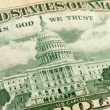by Joseph V. Amato, President and Chief Investment Officer—Equities, Neuberger Berman
Last week, Erik Knutzen warned about the many “trip hazards” in store for investors, from the U.S. debt ceiling and the fragility of U.S. regional banks, to weakening economic data, sticky inflation and tighter credit conditions. But while it’s easy to see these issues weighing on and generating volatility in bonds, equity markets seem unconcerned.
Why have equities—and the S&P 500 Index, specifically—been so resilient so far this year?
Economic fundamentals can go some way to answering that question. But an “optical illusion” at the heart of the index may be an equally important part of the explanation.
Relatively Benign
The economic slowdown, while clear and persistent, has been mild, so far.
Nominal GDP growth has come down slowly and real GDP growth has remained positive, in both cases due mainly to the resilient U.S. labor market and a gradual decline in inflation. U.S. inflation ticked lower again last week. Jobs markets worldwide have been surprisingly strong in the face of rising interest rates.
As for credit conditions, last week saw the release of the latest survey of U.S. banks’ senior loan officers, and the data was mixed rather than outright bad. Demand for new loans appears to be slowing at a rate unseen since the Global Financial Crisis, but lenders’ tightening of credit standards remains commensurate with only a mild recession. The eurozone equivalent came out the week before and, similarly, it showed credit standards tightening to 2011-crisis levels in the first quarter, but also optimism in second-quarter expectations.
While the runway for a soft landing remains very narrow, in our view, and the U.S. Federal Reserve’s own forecasters anticipate a recession, the fact that market participants can still talk about a soft landing at all might explain the lack of bearish sentiment.
As long as bank resolutions continue to be manageable and the U.S. meets all of its debt payments, the next few quarters of declining inflation and plateauing interest rates may begin to look relatively benign.
Narrowness
That might sound plausible—but then there’s the “optical illusion.”
Has the S&P 500 Index really been resilient this year? Or is it more like two very different indices, one that has performed very well and one not so well?
The first of those indices includes just seven “mega-cap” companies that have built global dominance in their respective industries: Meta, Apple, Amazon, Alphabet, NVIDIA, Microsoft and Tesla. Let’s call it the FAANG+ Index. Each company’s market capitalization is over half a trillion dollars.
Those seven companies account for a quarter of the market capitalization of the S&P 500 and 90% of its 8% return year-to-date—a narrowness of leadership that has not been seen for decades. This is quite unique to the U.S. large-cap market.
Then there is the rest of the index.
Distorted
This matters because investors are used to thinking about index earnings and valuation estimates in aggregate.
The current consensus S&P 500 Index earnings estimate for calendar year 2023 is $220 per share, which gives a forward price-to-earnings multiple of 19 times.
That looks expensive relative to the 20-year median of 16 times. Should the earnings estimate decline to $200 per share and the multiple to 16 times, it would imply a fall of more than 20% for the index.
In reality, however, most of the S&P 500 Index is trading not at 19 times 2023 earnings, but 17 times, which is closer to the long-run average. The aggregate number is distorted by the fact that our FAANG+ Index is trading on a multiple of almost 30 times earnings.
Bifurcation
Particularly after their resilience through first-quarter earnings season, it’s not unreasonable to believe that, in a slowdown, the earnings of these mega-cap, less cyclical companies might decline by less than those of the rest of the index.
In that scenario, if index earnings declined to $200 per share, and if the bulk of the index maintained the long-run average multiple of 16 times, and if the FAANG+ Index multiple declined by around three points, the downside for the S&P 500 would begin to look more like 10%-plus, rather than 20%-plus.
Make no mistake: we are cautious. We think inflation will be stickier than consensus estimates, that rates will stay higher for longer, and that earnings have further to decline as those high rates and tight financial conditions start to bite. Narrow, concentrated leadership in the stock market has historically been a negative leading indicator, and the fact that it comes from such an extremely small and high-quality group of stocks on this occasion only reinforces our caution.
That said, recognizing the bifurcation of the index can help us appreciate that it is not as it appears on the surface—which might explain why market participants appear less concerned that one might expect.
Copyright © Neuberger Berman















